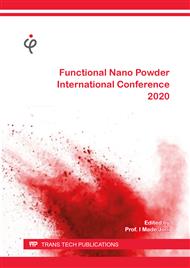[1]
Janjarasskul, T., Krochta, J., Edible Packaging Materals, Annu Rev Food Sci Technol. 1 (2010) 415–448.
DOI: 10.1146/annurev.food.080708.100836
Google Scholar
[2]
Erkmen, O., General Characteristics of Edible Films Abstract, J Food Biotechnol Res. 2 (2018) 1–4.
Google Scholar
[3]
Bourtoom, T., Review Article Edible films and Coatings : Characteristics and Properties, Int Food Res J. 15 (2008) 237–48.
Google Scholar
[4]
Santoso, B., Amilita, D., Priyanto, G., Pengembangan Edible Film Komposit Berbasis Pati Jagung dengan Penambahan Minyak Sawit dan Tween 20 (Development of Composite Edible Film Based on Corn Starch with Addition of Palm Oil and Tween 20), Agritech. 38 (2018) 119–204.
DOI: 10.22146/agritech.30275
Google Scholar
[5]
Butler, B.L., Vernago, P.J., Testin, R.F., Bunn, J.M, Wiles, J.L., Mechanical and Barier Properties of Edible Chitosan Films as affected by Composition and Storage, J Food Sci. 61 (1996) 953–61.
DOI: 10.1111/j.1365-2621.1996.tb10909.x
Google Scholar
[6]
Rochima, E., Fiyanih, E., Afrianto, E., Joni, I. M., Subhan, U., Panatarani, C., Efek Penambahan Suspensi Nanokitosan Pada Edible Coating Terhadap Aktivitas Antibakteri, JPHPI. 21 (2018) 1-10.
DOI: 10.17844/jphpi.v21i1.21461
Google Scholar
[7]
Information on http://www.sbu.ac.uk/.
Google Scholar
[8]
Fakhouri, F.M., Martelli S.M., Caon, T., Velasco, J.I, Buontempo, R.C, Bilck, A.P., Helena, L., Mei, I., The Effect of Fatty Acids on The Physicochemical Properties of Edible Films Composed of Gelatin and Gluten Proteins, LWT - Food Sci Technol. Elsevier Ltd (2017).
DOI: 10.1016/j.lwt.2017.08.056
Google Scholar
[9]
Jiménez, A., Fabra, M.J., Talens, P., Chiralt, A., Effect of Lipid Self-Association on The Microstructure and Physical Properties of Hydroxypropyl-Methylcellulose Edible Films Containing Fatty Acids, Carbohydr Polym. 82 (2010) 585–93.
DOI: 10.1016/j.carbpol.2010.05.014
Google Scholar
[10]
Ketaren, S., Pengantar Teknologi Minyak dan Lemak Pangan, UI-Press, Jakarta, 2005, p.138.
Google Scholar
[11]
Susilowati, E., Fajri, L., Pembuatan Edible Film Kitosan-Maizena dengan Aditif Virgin Coconut Oil (VCO), In: Seminar Nasional Kimia dan Pendidikan Kimia Seminar Nasional Kimia dan Pendidikan Kimia. (2013) 521–529.
DOI: 10.31602/dl.v4i1.4872
Google Scholar
[12]
Fransiska, D., Aplikasi Karaginan untuk Pembuatan Pengemas Lapis Tipis Biodegradable dengan Komposit Wheat Gluten dan Lilin Lebah (Beeswax), In: Seminar Nasional Tahunan V Hasil Penelitian Perikanan dan Kelautan Universitas Gadjah Mada, Yogyakarta (2008).
DOI: 10.15578/jpbkp.v1i2.391
Google Scholar
[13]
Badan Standarisasi Nasional, Kadar Air: SNI-01-235, Jakarta, (2008).
Google Scholar
[14]
ASTM, Standard Test Methods for Water Vapor Permeability of Organic Coating Films, ASTM Book of Standards, Newyork, 1983, pp.238-242.
Google Scholar
[15]
Ali, U., Bijalwan, V., Mazumder, K., Basu, S., Kesarwani, A.K., Effect of β-Glucan-Fatty Acid Esters on Microstructure and Physical Properties of Wheat Straw Arabinoxylan Films, Carbohydr Polym, Elsevier Ltd. (2016).
DOI: 10.1016/j.carbpol.2016.12.036
Google Scholar
[16]
Indrianti, N., Pranoto, Y., Abbas, A., Preparation and Characterization of Edible Films Made from Modified Sweet Potato Starch through Heat Moisture Treatment, Indones. J. Chem. 18 (2018) 679–687.
DOI: 10.22146/ijc.26740
Google Scholar
[17]
Supeni, G., Cahyaningtyas, A.A., Fitrina, A., Karakterisasi Sifat Fisik dan Mekanik Penambahan Kitosan pada Edible Film Karagenan dan Tapioka Termodifikasi, J Kim Kemasan, 37 (2015) 103–110.
DOI: 10.24817/jkk.v37i2.1819
Google Scholar
[18]
Schmidt, R., Consuelo V, Marques L, Borges J., Water Vapor Barrier and Mechanical Properties of Starch Films Containing Stearic Acid, Ind Crop Prod., 41 (2013) 227–234.
DOI: 10.1016/j.indcrop.2012.04.038
Google Scholar
[19]
Nurhayati and Agusman, Edible Film Kitosan dari Limbah Udang, Squalen, 6 (2011) 38–44.
Google Scholar
[20]
Hugh, M. and Krochta, Sorbitol vs Gliserol Plasticized Whey Protein Edible Film: Integrated Oxygen Permeability and Tensile Strength Evaluation, J Agric Food Chem. 42 (1994).
DOI: 10.1021/jf00040a001
Google Scholar
[21]
Al-Hassan, A.A., Norziah, M.H., Starch-Gelatin Edible Films : Water Vapor Permeability and Mechanical Properties as Affected by Plasticizers, Food Hydrocoll., 26 (2012) 108–117.
DOI: 10.1016/j.foodhyd.2011.04.015
Google Scholar


